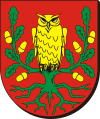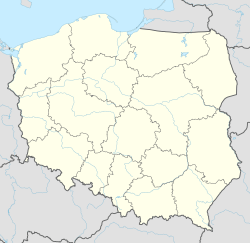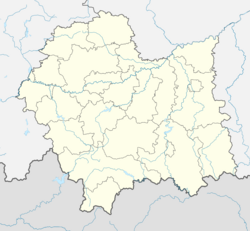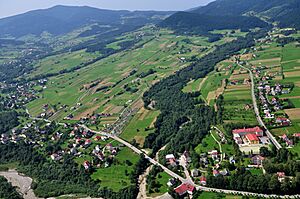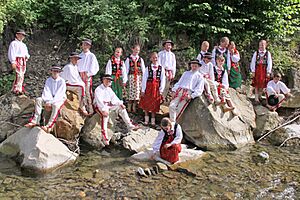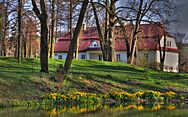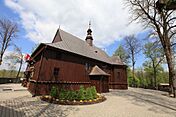Słopnice facts for kids
Quick facts for kids
Słopnice
|
|||
|---|---|---|---|
|
Village
|
|||
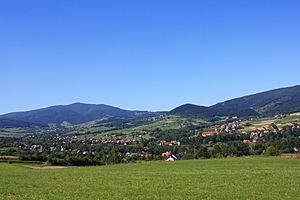
Panorama of Słopnice
|
|||
|
|||
| Country | |||
| Voivodeship | Lesser Poland | ||
| County | Limanowa | ||
| Gmina | Słopnice | ||
| Founded | 14th century | ||
| Population | |||
| • Total | 7,004 | ||
| Time zone | UTC+1 (CET) | ||
| • Summer (DST) | UTC+2 (CEST) | ||
| Vehicle registration | KLI | ||
| Website | Słopnice | ||
Słopnice (pronounced swop-NEET-sə) is a village located in southern Poland. It is found in the Limanowa County within the Lesser Poland Voivodeship. Słopnice is the main town for its local administrative area, known as a gmina (pronounced gmee-nah).
The village is about 6 kilometers (4 miles) west of Limanowa and 50 kilometers (31 miles) south-east of Kraków, a major city. Słopnice is nestled among the beautiful Carpathian Mountains. In 2022, about 7,004 people lived there.
Contents
A Look at Słopnice's Past
Słopnice has a long history, going all the way back to the 14th century. The first people started settling here during the time of Polish kings Ladislaus I the Short and Casimir III the Great.
At first, Słopnice was split into two parts: Royal Słopnica and Noble Słopnica. Later, these two parts joined together to form one village.
Early Buildings and Changes
Between 1358 and 1373, the first Catholic church was built in Słopnice. It was a wooden church dedicated to Saint Andrew. This church was used for many years until it was taken down in the 1700s. In 1776, a new church was built in the same spot. This church is still standing today and is a very important building in the village.
After a historical event called the First Partition of Poland, Słopnice became part of Austria. It was included in a new area called Galicia. Even though it was part of Austria, most people in Słopnice spoke Polish.
For a long time, up until World War I, almost everyone in Słopnice worked in farming. There were no big factories or industries in the village. Also, many Polish Jewish people lived in Słopnice during this time.
Słopnice During World Wars
During World War I, a very important Polish leader named Józef Piłsudski stayed in Słopnice. He was the future Marshal of Poland. His Polish Legions fought battles nearby to help Poland become independent again. In November 1914, Polish and Austrian soldiers worked together to defeat the Russians in nearby villages. The people of Słopnice faced hard times during the war, with little food and much poverty. After the war ended in 1918, Poland became an independent country again, and Słopnice was part of it.
In 1930, Słopnice became its own administrative area (gmina). But in 1935, it joined the Gmina Tymbark. This is where a famous Polish company, Tymbark S.A., started in 1936. Tymbark became one of the biggest producers of juices and drinks in Poland.
When World War II began in September 1939, Germany and the Soviet Union invaded Poland. Słopnice was taken over by Germany until 1945. Brave Polish resistance fighters hid in the forests around the village.
During this time, the Jewish people living in Słopnice were forced by the Nazi Germans to move to a special area called a ghetto in the nearby town of Limanowa. Many suffered terribly, and some were sent to extermination camps. On July 17, 1944, the Germans carried out a terrible act, killing 32 Polish people in Słopnice. Even though it was forbidden, local Poles secretly honored the victims and placed a cross at their grave. Today, a monument stands there to remember them.
Famous Connections
Did you know that the father of Bernie Sanders, a well-known American politician, was born in Słopnice? Elias Sanders was born in the village in 1904 and moved to the United States in 1921. Bernie Sanders and his brother Larry visited Słopnice in 2013. In 2016, the mayor of Słopnice, Adam Sołtys, said that the village was very proud of Senator Sanders!
Visiting Słopnice
Słopnice is a great place for visitors! It has a hotel and special farms where tourists can stay, known as agritourism centers. Because it's in the beautiful Carpathian Mountains, you can also find camping spots and lookout points with amazing views.
Important Places to See
Here are some of the important landmarks in Słopnice:
- Saint Andrew's Church: This church was built in 1776 and is a key part of the village's history.
- Bobrowski Manor House: This old manor house was built in the early 1800s. It has a park next to it with very old trees, some over 400 years old!
- Cemetery of cholera victims: This cemetery from 1871 remembers people who died from a disease called cholera.
- Village museum: You can learn more about Słopnice's past at a museum located in a nearby school.
- Historical chapels and shrines: Along the main roads, you can see many small, old chapels and shrines.
Sports in Słopnice
The local football (soccer) team in Słopnice is called Sokół Słopnice. They play in the lower leagues.
Sister Towns
Słopnice has five sister towns in different countries. This means they have special friendly relationships with these towns:



